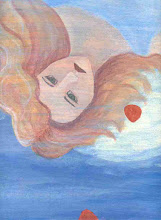What could be better than a book about a mermaid? A book about loads of mermaids in a parade. And not just mermaids, but other sea creatures and spirits, including the King and Queen of the Sea who "open" the ocean for the summer. How wonderful! Melanie Hope Greenberg has an easy, folksy way of writing that manages to catch people like me who have never visited Coney Island up in the excitement of the Mermaid Parade.
The artwork for Mermaids on Parade is similarly folksy, colorful and accessible. It was fun to find the little girl and her parents on each page and to follow their progress through the streets. It was also fun to spot the grown-up author/illustrator on one of the pages and to search for the peace dove.
This will be the thirtieth year of the Mermaid Parade on Coney Island. If you're going, be sure to pick up your copy of Mermaids on Parade.
http://mermaidsonparade.blogspot.com/2009/11/collect-melanies-art-and-books.html











